NationalEclipse.com | Oct 4, 2024 | National Eclipse Blog
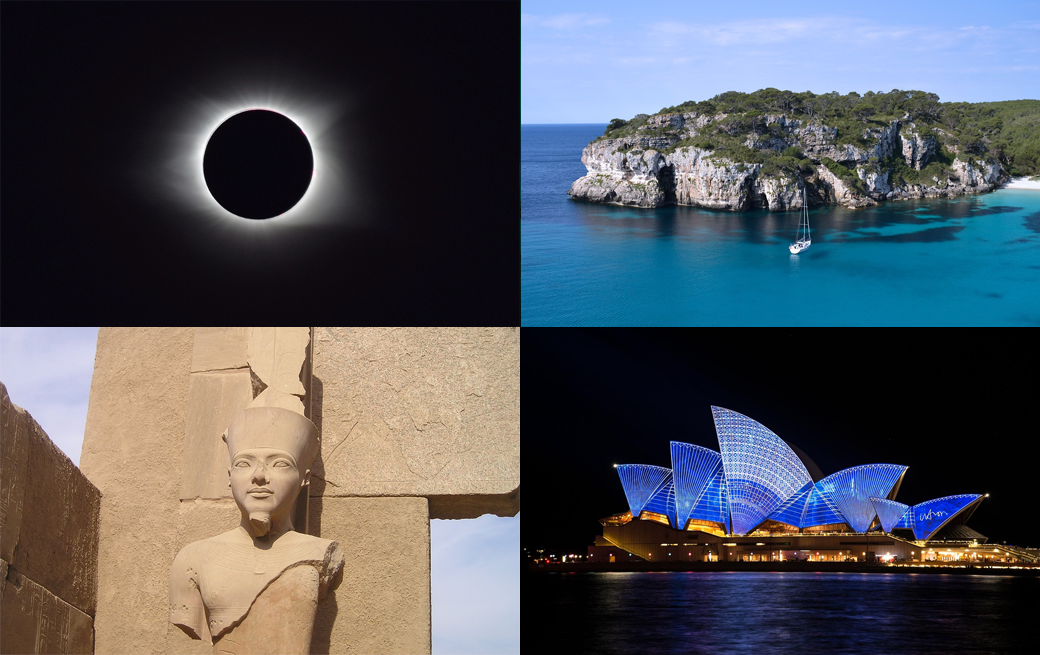
It's estimated that as many as 50 million people experienced the awe-inspiring sight of a total solar eclipse this past April when the Moon's shadow swept across Mexico, the U.S., and Canada. In the moments after seeing totality for the first time, it's not uncommon to hear people vow that they must see it again.
Although the U.S. won't experience another total solar eclipse until 2033, Earth itself will get three total solar eclipses in consecutive years from 2026 to 2028. What's more, eclipse chasers who enjoy traveling to far-off lands to experience the otherworldly spectacle of totality really lucked out with this upcoming eclipse trifecta. These three eclipses offer opportunities to view nature's greatest show from a diverse variety of exotic and easily accessible places. If you're up for it, you'll be able to see three total eclipses in three years from three very different places on Earth.
The 2026 Eclipse: Totality Over Iceland and Spain
While the paths of most total solar eclipses race across the planet in a roughly west-to-east direction, the total eclipse of August 12, 2026, arcs up and over the North Pole. The eclipse begins at sunrise on the uninhabited Taymyr Peninsula of Siberian Russia. It then loops over the top of the planet and drops down onto the frozen wastelands of eastern Greenland.
While virtually nobody will witness totality up to this point, the eclipse next crosses over the western shores of Iceland, the first easily accessible landmass along its journey. Unfortunately, the centerline of the eclipse completely misses the land of fire and ice, with only the eastern half of the path crossing over the country. This is noteworthy because the 2026 eclipse is a relatively short one. With a maximum duration of totality of only 2 minutes and 18 seconds, it would have been nice if locals and visitors could have planned to maximize their totality duration by viewing the eclipse on or near the centerline, where the duration of totality lasts the longest in any one place. On the bright side, the point of greatest duration—that singular spot along every total solar eclipse path centerline where totality lasts the very longest for that particular eclipse—happens to be located right off the coast of Iceland, ensuring that Icelanders will otherwise enjoy the longest durations possible despite the absence of a land-based centerline.
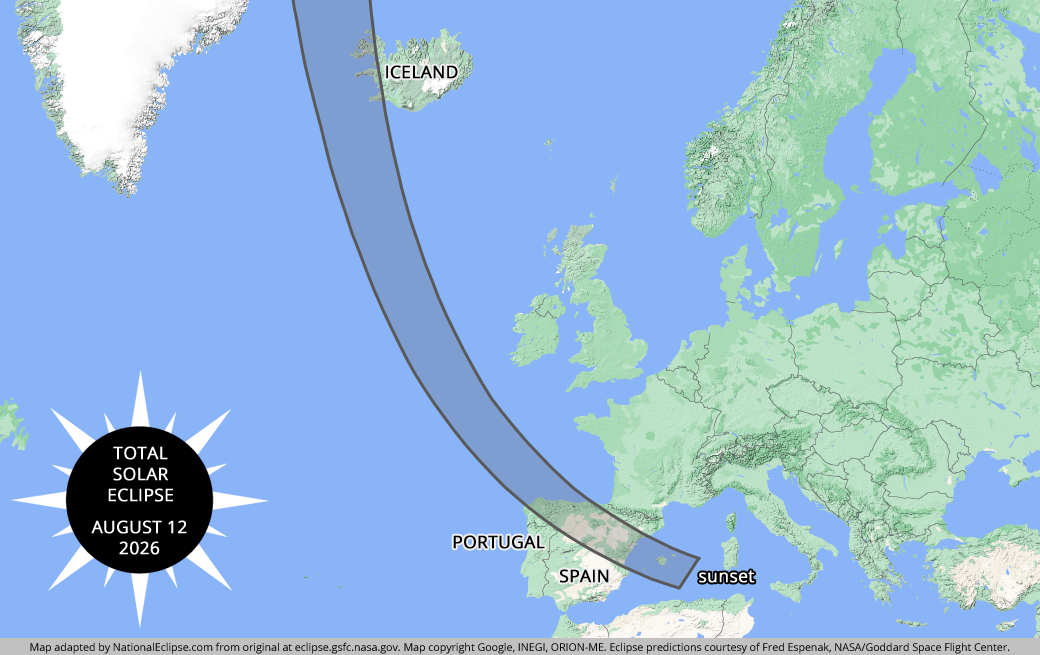
Also on the bright side, the eclipse occurs in August—one of the warmest months in Iceland, when average highs reach into the Fahrenheit 50s. And, finally, the path of totality conveniently crosses over Iceland's capital city, Reykjavík. Granted, Reykjavík sits relatively close to the eastern limit of the eclipse path, making totality durations rather short here. Observers can expect about just under a minute of totality in downtown Reykjavík, with durations dropping off the farther east you go.
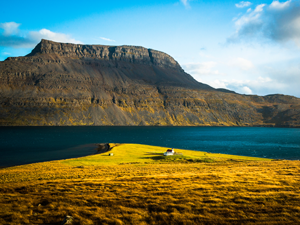
You can add an additional 40 seconds or so to your experience by positioning yourself on the Reykjanes Peninsula, where Iceland's main international airport is located. But if you want the longest duration possible, the very best place to be in Iceland is out on the Snæfellsnes Peninsula or the southwestern tip of the Westfjords, where durations will break the two-minute mark.
Once the eclipse leaves Iceland, it sweeps down over the North Atlantic until eventually reaching the Iberian Peninsula. From this point on, the eclipse belongs primarily to Spain, although technically the path of totality does cross over a tiny portion of Portugal. A couple of small Portuguese villages will experience totality for a handful of seconds, which is nice for the locals, but visitors should locate themselves much closer to the centerline somewhere in Spain for significantly longer durations.

The eclipse cuts across a wide swath of northern Spain. Unfortunately, most of Madrid is perched just outside the southern line of the totality zone. On the northern side, Barcelona also misses the cut. But several other large cities, including Valencia, Bilbao, and Zaragoza, are all located inside the path.
With a duration of totality that's been steadily decreasing since Iceland, the eclipse comes to an end out in the Mediterranean after crossing over all four of Spain's Balearic Islands. Both Mallorca and Ibiza, popular with tourists all year round, are intriguing possibilities for an eclipse viewing in 2026. Since the Sun will be very low in the sky at this point in the eclipse timeline, the panoramic views of the sea horizon offered by the islands can help observers achieve an unobstructed view of totality. All things considered, Mallorca is probably the best bet here. The centerline cuts right across the island, just south of the city of Palma, still ensuring a relatively decent duration of totality—about 1:36 on the centerline—for an eclipse nearing its end that was already short to begin with.
The 2027 Eclipse: Totality Over Spain, Morocco, Egypt, and More
Before discussing geography, the most exciting thing to note about the August 2, 2027, total solar eclipse is its monumental duration of totality. At the point of greatest duration, the Sun will be completely obscured by the Moon for an unbelievable 6 minutes and 23 seconds, which is only about a minute less than the theoretical maximum for a total solar eclipse on Earth. That's a long time to stand in the shadow of the Moon!

Unlike the 2026 eclipse, this one crosses over a lot more countries, although some of them are decidedly not travel-friendly destinations. After commencing its journey out in the Atlantic Ocean, the eclipse first crosses over Spain—the second total solar eclipse in as many years for this popular European destination. This time, though, the path of totality only skirts the extreme southern coast of the country as it tracks west-to-east through the Strait of Gibraltar. The cities of Málaga and Cádiz are both located inside the path, although both are rather close to the edge of the totality line, especially Málaga. Also inside the path is the British Overseas Territory of Gibraltar and its famous rock. In Gibraltar, observers can expert a very generous duration of totality of about 4 minutes and 27 seconds.
On the other side of the narrow strait, over in Africa, totality will be seen in the northern reaches of Morocco, with the centerline passing just south of Tangier, the third largest city in the country. For all total solar eclipses, the duration of totality increases along the centerline up until it reaches its point of greatest duration and then begins to decrease on the other side. Even this early on, still more than 2,000 miles away from that maximum point, durations on the centerline here in Morocco are already approaching the five-minute mark.
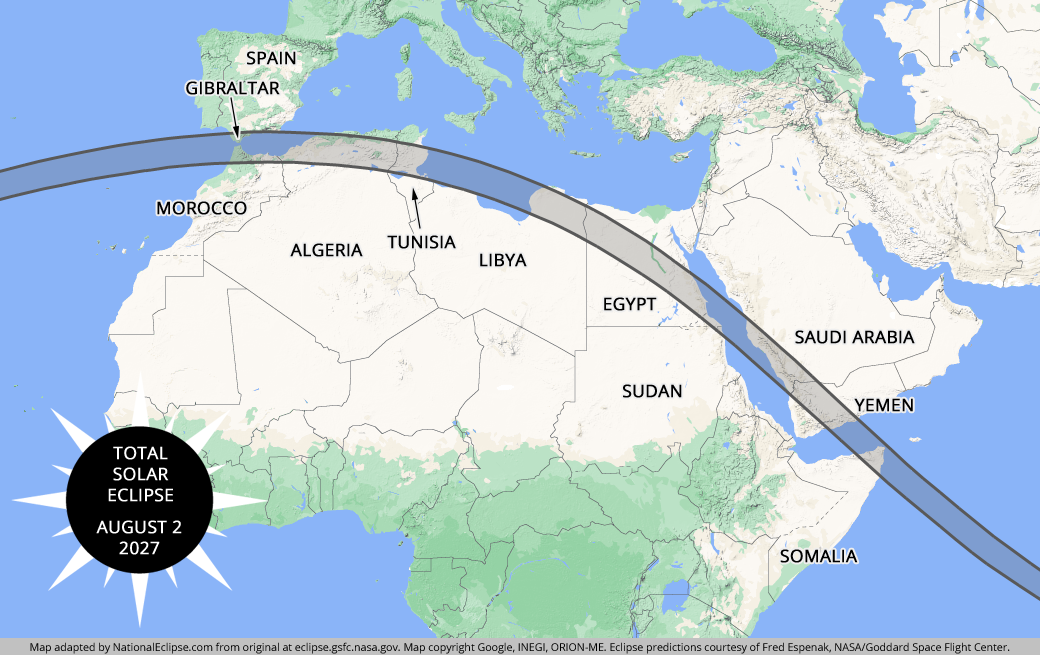
Beyond Morocco, the path of totality continues to track across northern Africa. It crosses over Algeria, Tunisia, and Libya. In light of the current situation in the Middle East, only time will tell what the travel outlook might look like in this general part of the world three years from now. As of this writing, the U.S. State Department maintains a Level 2 "Exercise Increased Caution" advisory for Algeria and Tunisia, which is the same as that for many European nations. However, certain parts of these countries, including areas that are inside the eclipse path, are explicitly labeled as Level 4—"Do Not Travel." As for Libya, the United States, Canada, the United Kingdom, and Australia all strongly warn their citizens against traveling to any part of Libya for any reason.
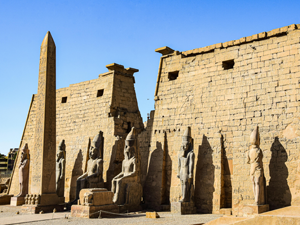
Arguably, the true dream destination for the 2027 total solar eclipse is Egypt. Not only is this where the eclipse reaches its maximum duration of 6 minutes and 23 seconds, but it happens when the centerline crosses the Nile River just north of Luxor. Imagine witnessing the ancient wonder of totality for over six minutes from the Valley of the Kings or the Luxor Temple or from a Nile River cruise. And if that weren't enough, the chances for cloudless skies in August are all but a certainty.
Again, it's impossible to predict what the travel situation might be like for this region in three years. For some time now, the U.S. State Department has maintained a Level 3 "Reconsider Travel" advisory for Egypt and some areas of the country have a Level 4 "Do Not Travel" warning. On the other hand, plenty of travelers report that they haven't experienced any major problems while visiting Cairo or the popular Nile River sites south of the city. Many travelers to Egypt also opt to visit the country with a large tour group and guide, which usually includes security personnel. When the time comes, eclipse chasers will need to evaluate their own risk tolerance when deciding whether Egypt is the right eclipse viewing destination for them personally.
Before leaving the African continent, the eclipse skims a very small portion of Sudan—another Level 4 "Do Not Travel" country. It then crosses the Red Sea and skirts the southwestern shores of Saudi Arabia, including the city of Jeddah. Similar to Algeria and Tunisia, the United States has issued a Level 2 "Exercise Increased Caution" advisory for Saudi Arabia in general while also warning against all travel to certain parts of the country, including certain areas that are inside the eclipse path. Finally, before coming to an end way out in the Indian Ocean, the eclipse also crosses over Yemen and Somalia—two more countries that most western governments strongly warn their citizens against traveling to for any reason whatsoever.
The 2028 Eclipse: Totality Over Australia and New Zealand
Right on the heels of a six-minute total solar eclipse in 2027 is another doozy less than a year later—a five-minute stunner on July 22, 2028. This one crosses over Australia and New Zealand, peaking with a maximum duration of totality of 5 minutes and 10 seconds.
The eclipse begins at sunrise in the Indian Ocean, crossing over a couple of small Australian island territories (Cocos and Christmas) before touching down on the top of the northern coast of Western Australia. This is where the point of greatest duration occurs. From here on out, the duration on the centerline will gradually decrease from its high point, but it stays above the three-minute mark until leaving the continent.

From Western Australia, the eclipse path crosses into Australia's Northern Territory, Queensland, the northeast corner of South Australia, and New South Wales, respectively. NSW is presumably where the majority of people will witness totality down under. In fact, as it sweeps across the continent, the path makes a beeline for Australia's largest population center.
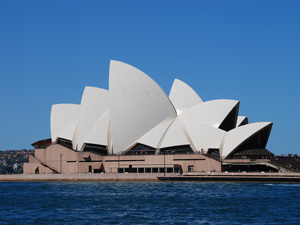
A city can't be any better positioned for a total solar eclipse than Sydney is on July 22, 2028. The centerline of the eclipse cuts directly across the heart of the city, slicing through about four miles south of the Sydney Opera House. If you're standing at said Opera House at exactly 1:59pm, you'll see darkness descend on Sydney Harbour for about 3 minutes and 48 seconds. The other good news is that although July is the dead of winter in the Southern Hemisphere, it rarely gets very cold in Sydney.
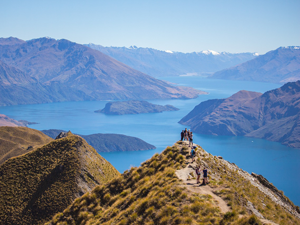
After the eclipse leaves Australia, it ferries itself across the Tasman Sea and makes landfall again in New Zealand. The eclipse travels over the South Island of New Zealand, the less populous of the two main islands. For a visitor, seeing totality in New Zealand will most likely require flying into Christchurch and then driving south almost all the way to the end of the island to get inside the eclipse path. New Zealand will get another total solar eclipse in 2037, with a path of totality that crosses the North Island not far from Auckland, so if you don't mind delaying your trip to New Zealand for another nine years, Australia might be the better option for 2028.